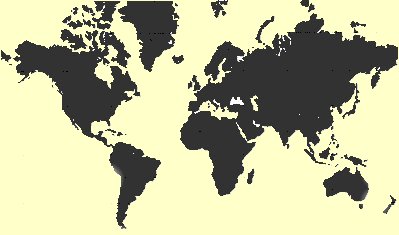Horizontal Diffusion
Today, the advantage of being horizontal. The University of Houston's College of Engineering presents this series about the machines that make our civilization run, and the people whose ingenuity created them.
Consider an odd fact you may not've noticed. It is that, of the four large continents, only one runs east and west. It's the largest one, Eurasia, formed by Europe and Asia. Eurasia is nine thousand miles wide. Both the Americas and Africa run north and south.
Biologist Jared Diamond looks at that fact and reminds us that climate largely follows latitude, not longitude. Eurasia is not only the largest of the continents, but it's the only one where you can travel more than three thousand miles without encountering radical changes in the general climate.
That fact has determined the nature of life on those continents. For example, the llama never found its way from South America into Central America, nor did the bison move south beyond the present-day United States. Mexican corn couldn't grow in Canada.
In Eurasia, horses and cattle spread to both Spain and China. After agriculture arose in the Middle East, ten thousand years ago, it spread methodically eastward and westward. Not only did domestic plants have lands to move into; the people who grew them also followed the climates they'd learned to tolerate.
That spread didn't strictly follow lines of latitude, but it zigged slightly to accommodate climatic variations. Agriculture followed a path through the Balkans and diagonally across Europe until it reached the temperate parts of Ireland around 3000 BC.
The humans who used domesticated animals and agriculture were part and parcel of those technologies. As we moved with our animals and agriculture, our technologies followed. Two particular technologies, virtually unknown in Africa or the Americas, spread laterally in Eurasia. They were writing and the wheel.
The wheel, invented fifty-five hundred years ago at the northern end of the fertile crescent, diffused rapidly across Eurasia. Ancient Mexicans thought of the wheel, but since agriculture didn't move north or south, neither did the wheel. It died in isolation.
Writing, invented fifty-two hundred years ago in Egypt , traveled rapidly throughout Eurasia and across North Africa, but not downward into sub-Saharan Africa. Writing also arose in Central America, but, like the wheel, it stayed there.
So agriculture and domesticated animals came late to the other three large continents, and, once there, they stayed horizontally stratified. Diamond's radical suggestion is that the lateral diffusion of agriculture in Eurasia jump-started all its technologies.
Long ago, Daniel Webster had a visceral understanding of this process. In 1840, just before he became Secretary of State, he wrote,
When tillage begins, other arts follow.
The farmers therefore are the founders of civilization.
Now Diamond suggests that early inhabitants were able to give full expression to that natural kinship of agriculture and technology on only one continent -- only in horizontal Eurasia.
I'm John Lienhard, at the University of Houston, where we're interested in the way inventive minds work.
(Theme music)
Diamond, J., Spacious Skies and Tilted Axes. Guns, Germs, and Steel, W.W. Norton & Company, 1999, pp. 176-191.
